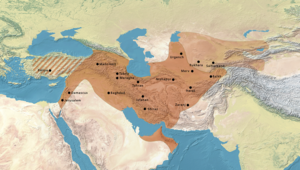செல்யூக் பேரரசு
மாபெரும் செல்யூக் பேரரசு (Great Seljuq Empire, பாரசீக மொழி: دولت سلجوقیان, அரபு மொழி: الدولة السلجوقية) இடைக்காலத்தில் விளங்கிய ஒரு துருக்கிய-பாரசீக[13] சுன்னி இசுலாமியப் பேரரசு ஆகும். ஓகுசு துருக்கியர்களின் (Oghuz Turks) கிளை இராச்சியம் ஒன்றிலிருந்து உருவானது[14]. செல்யூக் பேரரசின் ஆட்சியின் கட்டுப்பாட்டில் கிழக்கே இந்துகுஷ் முதல் அனத்தோலியா வரையும் மத்திய ஆசியாவிலிருந்து பாரசீக வளைகுடா வரையும் பரந்த நிலப்பரப்பு இருந்தது. தங்கள் உறைவிடமான ஏரல் கடல் பகுதியிலிருந்து முதலில் கோராசன் எனப்படும் வடக்கு ஈரான் பகுதியைப் பிடித்து பின்னர் பாரசீகத்தை ஆட்கொண்டு இறுதியில் கிழக்கு அனத்தோலியா வரை முன்னேறினார்கள்.
செல்யூக் பேரரசு | |
|---|---|
| 1037–1194 | |
முதலாம் மாலிக் ஷாவின் ஆட்சியின் போது அண். 1090இல் செல்யூக் பேரரசு. மேற்கே அனத்தோலியாவானது உரூம் சுல்தானகமாக சுலைமான் இப்னு குதல்மிசுவின் சுதந்திரமான ஆட்சியின் கீழ் பைசாந்தியப் பேரரசுடன் பிணக்குடன் இருந்தது. கிழக்கே, காரா கானிய கானரசு 1089இல் ஒரு திறை செலுத்திய அரசாக உருவானது. காரா கிதையிடம் வீழ்ச்சியடையும் வரை இந்நிலை அரை நூற்றாண்டுக்கு நீடித்தது.[1][2] | |
| நிலை | பேரரசு |
| தலைநகரம் | |
| பேசப்படும் மொழிகள் | |
| சமயம் | சன்னி இசுலாம் (அனாபி) |
| அரசாங்கம் | கலீபகத்தின் கீழான அரசு (உரிமைப் படி)[8] சுதந்திரமான சுல்தான் (நடை முறைப் படி) |
| கலீபா | |
• 1031–1075 | அல் கைம் |
• 1180–1225 | அல்-நசீர் |
| சுல்தான் | |
• 1037–1063 | துக்ரில் (முதல்) |
• 1174–1194 | மூன்றாம் துக்ரில் (கடைசி)[9] |
| வரலாறு | |
• துக்ரிலின் கீழ் நிறுவப்படுதல் | 1037 |
• தந்தனகன் யுத்தம் | 1040 |
• மன்சிகெர்து யுத்தம் | 1071 |
• முதலாம் சிலுவைப் போர் | 1095–1099 |
• கத்வான் யுத்தம் | 1141 |
• குவாரசமியப் பேரரசு செல்யூக் பேரரசை இடம் மாற்றியது[10] | 1194 |
| பரப்பு | |
| 1080 மதிப்பீடு.[11][12] | 3,900,000 km2 (1,500,000 sq mi) |
செல்யூக் வம்சத்தின் செல்யூக் பெக் நிறுவ முயன்ற செல்யூக் பேரரசு அவரது மகன் துக்ருல் பெக் காலத்தில் 1037ஆம் ஆண்டு அமைக்கப்பட்டது.செல்யூக்கினர் பிளவுபட்டிருந்த கிழக்கு இசுலாமிய உலகை ஒற்றுமைப்படுத்தி முதலாம் மற்றும் இரண்டாம் சிலுவைப் போர்களில் முக்கியப் பங்காற்றினர். மிகவும் பாரசீக தாக்கம் கொண்ட[13] பண்பாட்டையும் பாவித்த செல்யூக்கர்கள் துருக்கிய-பாரசீக மரபை வளர்த்தெடுத்தனர்.
மேற்கோள்கள்
தொகு- ↑ Stone, Norman (1989). The Times atlas of world history. Maplewood, N.J.: Hammond Incorporated. p. 135. பன்னாட்டுத் தரப்புத்தக எண் 0723003041.
- ↑ Peacock 2015, ப. 62–63.
- ↑ 3.0 3.1 Savory, R. M., ed. (1976). Introduction to Islamic Civilisation. Cambridge University Press. p. 82. பன்னாட்டுத் தரப்புத்தக எண் 978-0-521-20777-5.
- ↑ Black, Edwin (2004). Banking on Baghdad: Inside Iraq's 7,000-year History of War, Profit and Conflict. John Wiley and Sons. p. 38. பன்னாட்டுத் தரப்புத்தக எண் 978-0-471-67186-2.
- ↑ 5.0 5.1 5.2 C.E. Bosworth, "Turkish Expansion towards the west" in UNESCO History of Humanity, Volume IV, titled "From the Seventh to the Sixteenth Century", UNESCO Publishing / Routledge, p. 391: "While the Arabic language retained its primacy in such spheres as law, theology and science, the culture of the Seljuk court and secular literature within the sultanate became largely Persianized; this is seen in the early adoption of Persian epic names by the Seljuk rulers (Qubād, Kay Khusraw and so on) and in the use of Persian as a literary language (Turkish must have been essentially a vehicle for everyday speech at this time)."
- ↑ Stokes 2008, ப. 615.
- ↑ Concise Encyclopedia of Languages of the World, Ed. Keith Brown, Sarah Ogilvie, (Elsevier Ltd., 2009), 1110; "Oghuz Turkic is first represented by Old Anatolian Turkish which was a subordinate written medium until the end of the Seljuk rule."
- ↑ Peter M. Holt (1984). "Some Observations on the 'Abbāsid Caliphate of Cairo". Bulletin of the School of Oriental and African Studies (University of London) 47 (3): 501–507. doi:10.1017/s0041977x00113710.
- ↑ Grousset, Rene, The Empire of the Steppes, (New Brunswick: Rutgers University Press, 1988), 167.
- ↑ Grousset, Rene (1988). The Empire of the Steppes. New Brunswick: Rutgers University Press. pp. 159, 161. பன்னாட்டுத் தரப்புத்தக எண் 978-0-8135-0627-2.
In 1194, Togrul III would succumb to the onslaught of the Khwarizmian Turks, who were destined at last to succeed the Seljuks to the empire of the Middle East.
- ↑ Turchin, Peter; Adams, Jonathan M.; Hall, Thomas D. (December 2006). "East-West Orientation of Historical Empires". Journal of World-Systems Research 12 (2): 223. பன்னாட்டுத் தர தொடர் எண்:1076-156X. http://jwsr.pitt.edu/ojs/index.php/jwsr/article/view/369/381. பார்த்த நாள்: 13 September 2016.
- ↑ Rein Taagepera (September 1997). "Expansion and Contraction Patterns of Large Polities: Context for Russia". International Studies Quarterly 41 (3): 496. doi:10.1111/0020-8833.00053. http://www.escholarship.org/uc/item/3cn68807.
- ↑ 13.0 13.1 M.A. Amir-Moezzi, "Shahrbanu", Encyclopaedia Iranica, Online Edition, (LINK): "... here one might bear in mind that non-Persian dynasties such as the Ghaznavids, Saljuqs and Ilkhanids were rapidly to adopt the Persian language and have their origins traced back to the ancient kings of Persia rather than to Turkmen heroes or Muslim saints ..."
- ↑ *Jackson, P. (2002). "Review: The History of the Seljuq Turkmens: The History of the Seljuq Turkmens". Journal of Islamic Studies (Oxford Centre for Islamic Studies) 13 (1): 75–76. doi:10.1093/jis/13.1.75.
உசாத்துணைகள்
தொகு- Previte-Orton, C. W. (1971). The Shorter Cambridge Medieval History. Cambridge: Cambridge University Press.
- Tetley, G. E. (2008). The Ghaznavid and Seljuk Turks: Poetry as a Source for Iranian History. Abingdon. பன்னாட்டுத் தரப்புத்தக எண் 978-0-415-43119-4.
- All Empires Online History Community: The Seljuk Empire
